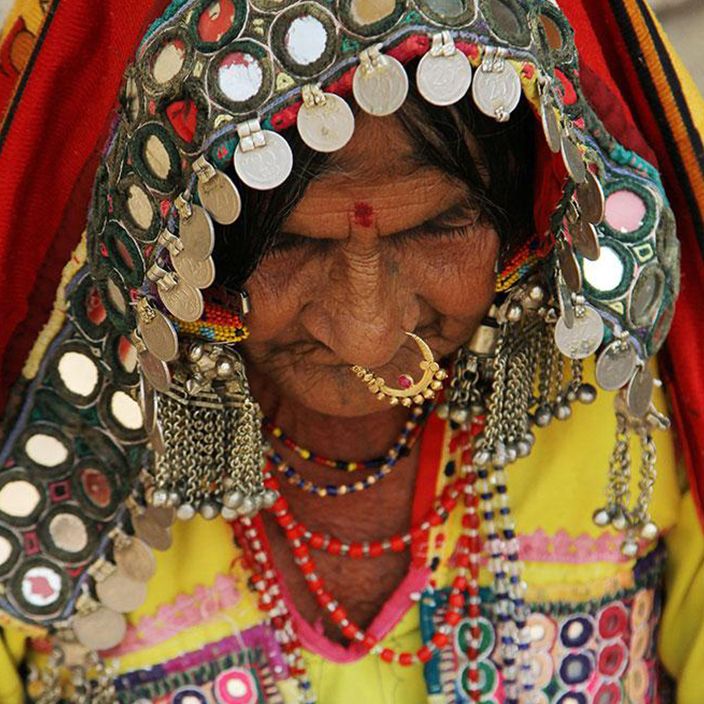For best prices and early deliveries, WhatsApp us at. 918488070070

Lambani
Adored for being a blend between mirror work, cross-stitching, pattern darning, overlaid stitching, beadwork, quilting stitches, and appliqué patchwork, Lambani embroidery is genuinely one of a kind. It is done by an Indian gypsy (banjara) community called the ‘Lambanis’, considered a semi-nomadic tribe. Fabrics with this kind of embroidery have a unique and terrific texture and a bohemian twist that makes it popular among locals and tourists. The base material of choice is either a locally dyed cotton khadi or power loom cloth to uplift the local small-scale textile industry. This handicraft is practised in several villages around Hampi and the Bellary district, such as Sandur, Keri Tanda, Mariyammanahalli, Kadirampur, Sitaram Tanda, Bijapur, and Kamalapur.
Tracing Its Origin
Originally from Marwar, this tribe is known as the ‘banjaras’ who move from one place to another, isolating and assimilating themselves. Historians believe the term, ‘Lambani’, is derived from ‘lavanah’, which means salt. This theory makes sense because the tribe is assumed to have been pastors or salt traders. It is said that they also traded wood, grains, pulses, and other products while moving from one place to another.
During the rule of the great Mughal Emperor Aurangzeb in the 17th Century, the Lambani tribe became an essential part of their armies. They mainly aided the military in transporting supplies and arms to South India during the war in Deccan. Once the war ended, the tribe settled in the south - working for the British and Tipu Sultan. Despite being in service to them, the Lambanis faced several problems.
For example, the lack of connected roads, laws, and criticism of their nomadic lifestyle. To cope with this, they separated and formed groups or ‘tandas’ (villages) named after the area they settled in. Although it became difficult to earn a living, men of the tribe worked as labourers, while the women chose to put together traditional dresses, bags, and leather articles. The hand-embroidered clothes are integrated as an essential part of the bridal trousseau packages.
Ultimately, the efforts the tribe’s women put in led to the preservation of their rich culture and heritage through Lambani embroidery. Its vibrant and intricate nature has gained the attention of many across national and international borders.
How It’s Done
Lambani’s production process begins with artisans selecting the base material for Lambani’s production. This is based solely on the pattern which will be stitched. Depending on the order and occasion, the pattern is also decided. Next, threads of contrasting colours are chosen in accordance with the base cloth, which is generally red or blue. The base cloth is treated and dyed by locals with expertise in chemical and vegetable dyes.
Fourteen different kinds of stitches are used in Lambani embroidery, namely Gadri, Bhuriya, Kaudi, Kilan, Relo, Maki, Suryakanti Maki, Pote, Nakra, Jollya, Tera Dora, Vele, Kans, and Bakkya.
Most of these stitching techniques keep to a geometric pattern consisting of various shapes and lines, such as triangles, squares, circles, rectangles, diagonal lines, and parallel lines. With the addition of alluring embellishments like beads, mirrors, coins, and cowrie shells, a cheerful arrangement of designs and colours is created.
At times, women also stitch pieces of fabric onto the base material. This is known as ‘kangura’ appliqué patchwork, a time and labour-intensive task.
Lambani Embroidery Today
In these contemporary times, the Lambani embroidery has gathered a lot of support. It has given it a global appeal and made it a fashion statement. It is often mistaken for ‘Kutchi embroidery’ because of mirror work. However, cowrie shells and coins are unique to Karnataka’s Lambani embroidery.
A local non-profit organisation, the Sandur Kushal Kala Kendra, is working with the tribe’s women to uplift their handicrafts. Due to their rigorous efforts, the Geographical Indication (GI) tag recognised the well-executed craftsmanship in 2010. It was granted to Sandur, a town in the Bellary district of Karnataka. Earned profits have substantially increased since then, and aided in improving the Lambani community’s standard of living. Other similar initiatives, such as the Peepul Tree, have generously contributed by spreading the word about the handicraft, leading to more supporters and sales. By working with these organizations, new and distinctive designs have also been introduced. Bags, bed linen, cushion covers, table runners, wall decor, pouches, multi-utility head covers, neck pieces, file covers, dupattas, blouses, kurtas, and skirts are some products that are being produced today.
There is no doubt that the community celebrates their culture and heritage through their exquisite Lambani work. The Lambani tribe had been restricted creatively as they were to follow their traditions. Nonetheless, they persevered till the time of the embroidery’s present-day revival, which aims to cater to modern tastes.
Lambani is a cultural community known for their exquisite banjara needle craft, as well as their expertise in kasuti and crewel embroidery. Items with Lambani embroidery can be purchased from designers like Vipul Shah and Devyani Mehrotra at Pernia’s Pop-Up Shop.
Image Credits
30 Stades | Asia Inch | D'source | First Post | Stotra Studio | Gaatha | Google arts and culture | Hampi Handicrafts | Real Bharat | IBB